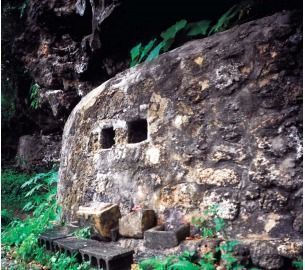Removed during the early Showa Era, 26 Ryukyuan skeletons found at Kyoto University

Skeletal bones removed by anthropological researchers from the Mumujana Grave located in Unten of Nakijin Village.
February 16, 2017 Ryukyu Shimpo
By Takahiro Miyagi
At least 26 sets of human skeletons, which had been removed from the Mumujana Grave in Unten of Nakijin Village by anthropological researchers during the early Showa Era, were found at Kyoto University. The skeletons had been preserved at the university for more than 75 years and were removed for research purposes, but have yet to be returned. The Nakijin Village Board of Education confirmed the existence of the skeletons at Kyoto University in its 2004 research.
Similarly, the remains of the Ainu were also removed and preserved at Hokkaido University, but have since been returned to the families of the deceased. Following this, some researchers are arguing that the Ryukyuan skeletons should also be returned to Okinawa. The right of indigenous peoples to request the remains to be returned is stipulated in the United Nations Declaration on the Rights of Indigenous Peoples, which was adopted in 2007.
A representative from The Ryukyu Shimpo asked a representative from Kyoto University questions, such as “Do you still have Ryukyuan bones?” and “Do you think that the excavations that were conducted at the time were appropriate?” However, the representative responded, “We will not be taking any questions regarding this matter.”
According to the research conducted by the Nakijin Village Board of Education, another 33 sets of skeletons that had been removed from the Mumujana Grave are currently preserved at the National Taiwan University located in Taipei, Taiwan. As of February 15, Taiwan University has not answered whether they have the skeletons in possession.
It was Takeo Kanaseki (1897-1983), an anthropologist and Kyoto Imperial University (now Kyoto University) assistant professor who removed the skeletons from the Mumujana Grave. He wrote in his book, “Ryukyuan Ethnography” (1978) that he had removed several sets of skeletons during excavations conducted all over Okinawa between 1928 and 1929. He also noted that Okinawan researchers were also involved. Kanaseki then donated the skeletons as specimens to the Kyoto Imperial University. He also took some skeletons with him to the Taihoku Imperial University (now National Taiwan University), where he was transferred to.
The Mumujana Grave, located on the northern side of Unten, halfway up a cliff, is a tangible cultural property designated by Nakijin Village. According to a historical document from the Ryukyu Kingdom, “Chuzan seifu” (1697), the Mumujana Grave was a gravesite for nobility. According to a representative from the Nakijin Village’s Board of Education, the Mumujana Grave, along with the Unishi Grave close by are believed to be the “gravesites for the royal family of the Hokuzan area or the Kanshu (Administrator) family.”
Kaneseki, his mentor Kenji Kiyono, and apprentice Koryo Kyo, all of whom were anthropologists, presented their papers based on the skeletons collected by Kaneseki and others. However even after that, the skeletons were not returned and had been preserved at the Kyoto University at least until 2004.
In Hokkaido, remains of the Ainu had been excavated from gravesites by anthropologists around the 1930s. More than 1600 sets of skeletons are preserved at 11 universities across the country. With the abolishment of the Protection Law of Hokkaido Aboriginals and increased efforts to regain the right of self-determination by the Ainu, the movement to have the remains returned has gathered momentum. In 2012, families of the deceased filed a suit against Hokkaido demanding the remains be returned. A compromise was reached last March, and 12 sets of skeletons were returned to the families last July.
Protection Law of Hokkaido Aboriginals
Enacted in 1899. Gave land to the Ainu and promoted farming. However, the land was confiscated if it had not been cultivated for the past 15 years. Japanization, or imperial education, was also thoroughly implemented. However, farming did not sit well for the Ainu since they made their living by hunting, causing the situation to go from bad to worse. Ainu elementary schools were established, but practicing the Ainu language and traditional culture were forbidden. The law was abolished when the Act on the Promotion of Ainu Culture was established in 1995.
(English translation by T&TC and Chelsea Ashimine)
Previous Article:Obstructing Henoko base construction becomes pillar of Onaga administration’s 2017 objectives
Next Article:Editorial: Taking of Ryukyuan bones for anthropology must be investigated and their return debated
[Similar Articles]
- Okinawan remains taken early in the Showa era returned from Taiwan University
- Nakijin Village to receive Ryukyuan remains from Taiwan University
- Researchers to establish a new association to request return of Ryukyuan remains
- Editorial: Taking of Ryukyuan bones for anthropology must be investigated and their return debated
- National Taiwan University announces intention to return 63 Ryukyuan remains excavated from Nakajin
 Webcam(Kokusai Street)
Webcam(Kokusai Street)


